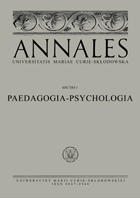Tatuowanie ciała w środowisku wolnościowym i więziennym – marginalizacja w kontekście społeczno-kulturowym
Tattooing the Body in Community at Large and in Prison Environment – Marginalisation in the Socio-Cultural Context
Author(s): Mariusz SnopekSubject(s): Penology
Published by: Wydawnictwo Naukowe Uniwersytetu Marii Curie-Sklodowskiej
Keywords: tattoo; body decorating; body branding; risk of marginalization; artistic tattoo; prison tattoo;
Summary/Abstract: The permanent body’s imprinting (decorating and branding) has been known since the dawn of history. The tattoo phenomenon (as one of many forms of body modifications) goes beyond the bounds of some marginal social groups. Nowadays, it is ascribed to many other social milieus and, by implication, it became an inherent element, not only underculture or subculture but also pop culture. In Poland, three types of tattoos can be distinguished: artistic, amateurish, and prison. For the purpose of the article, the types of tattoos occurring in Poland were divided into two groups: the tattoo made on freedom (artistic and amateurish tattoo) and the tattoo made in insulating establishment (prison tattoo). People with tattoos, independently of its types, function in a specific environment that presents an attitude of acceptance or negation. The risk of marginalisation appears differently in the case of freedom tattoo and in the case of prison tattoo. The article shows the main determinants conducing to localisation of an individual in a group liable to marginalisation. The conclusion of the text are the results of research conducted in 2005–2018 both in freedom and insulated milieu.
Journal: Annales Universitatis Mariae Curie-Skłodowska. Sectio J. Paedagogia-Psychologia
- Issue Year: 35/2022
- Issue No: 3
- Page Range: 219-235
- Page Count: 17
- Language: Polish

